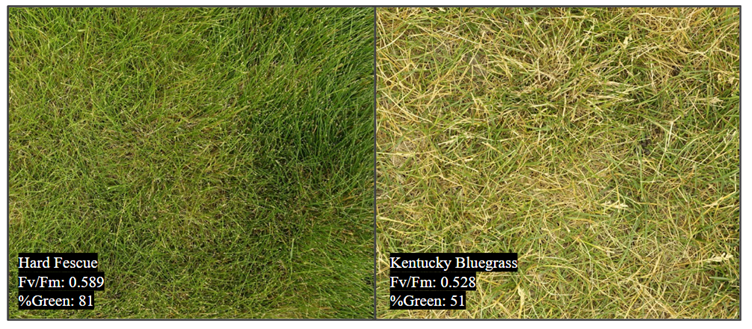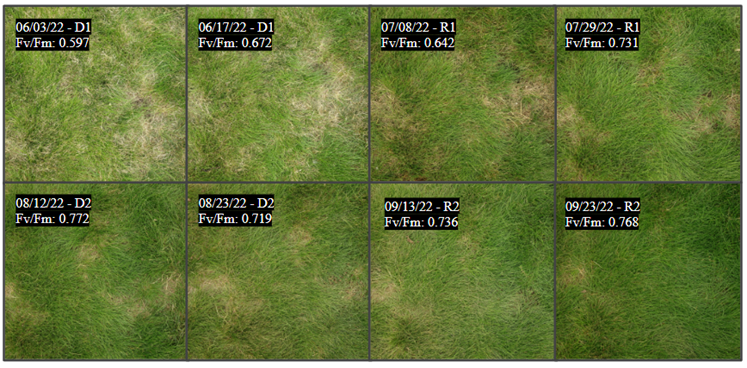By Jillian Turbeville
When it comes to lawn management, droughts in the Midwest have become a topic of concern. Generally, homeowners will mow their lawn in a scheduled manner (once a week) or based on grass growth rate (⅓ rule), but should we mow based on how stressed the grasses are? Although this can be partially unrealistic, having a basic understanding of how your lawn responds to times of heat and drought in summer may help keep your grass greener for a longer period of time.
Last summer, one of my research projects, funded by the Metropolitan Council, was to evaluate different turfgrass mixtures and their response to drought and heat. The turf plots were subjected to drought conditions under a rainout shelter for 28 days, followed by a recovery period, followed by a second 28-day drought. Because these drought periods occurred during the summer, the plots also experienced significant heat stress along with the drought. We used various tools to help identify turfgrass mixtures that performed well during these stressful conditions. Plots included monocultures of Kentucky bluegrass, perennial ryegrass, and hard fescue, as well as a number of two and three-way mixtures (66% hard fescue: 33% perennial ryegrass, for example). This winter, I analyzed the data and noticed an interesting connection between plant stress and leaf color: Can a lawn suffer from stressors like heat and drought, but present no symptoms?
| Drought 1 | Recovery 1 | Drought 2 | Recovery 2 | |||||
|---|---|---|---|---|---|---|---|---|
| Year | Fv/Fm | %Green | Fv/Fm | %Green | Fv/Fm | %Green | Fv/Fm | %Green |
| 2021 | 0.589 | 81.2 | 0.67 | 84.8 | 0.625 | 76.2 | 0.662 | 82 |
| 2022 | 0.619 | 59.4 | 0.738 | 78.9 | 0.724 | 70.9 | 0.768 | 83.4 |
Tools we currently use to understand plant stress indicators include a fluorometer that can test the plant’s photosynthetic performance as determined by a measurement referred to as Fv/Fm. If the Fv/Fm values drop below the optimal level of 0.79 to 0.84, the plant is considered stressed (Maxwell and Johnson, 2000). In addition, we analyzed pictures for the percentage of green. When comparing both percentages of green and Fv/Fm, we would assume that as the percentage of green decreases, the value of Fv/Fm would also decrease. However, data shown in Table 1 give different results: the Fv/Fm number pointed toward leaf stress, but the percent green remained high. This leads me to believe that our typical visual cues of a green lawn, will not always correlate with how stressed the lawn really is.

Lawns that contain hard fescue may look greener during summer drought, but will still be stressed physiologically. In Figure 1, we can see that hard fescue after the first drought exhibits a healthy look, but both plots have low Fv/Fm values. When comparing the look of a hard fescue plot over the span of a summer, very little visual color variation occurs while the Fv/Fm value indicates a difference in plant stress (Figure 2). By researching the history of hard fescue heat and drought tolerance, we can find an explanation to why this may be happening.

It has been found that hard fescues responding to heat and drought stress use different physiological strategies to survive. Hard fescue modifies its response to photosynthesis in drought conditions: membrane proteins involved in photosynthesis are down-regulated and heat responsive proteins are up-regulated (Wang et al., 2017). During heat waves, the photosynthetic system becomes less efficient and will cause a lower availability/accumulation of nutrients (Qu, Luping et al., 2020). When our heat-tolerant lawns are acclimating to these high temperatures and slowing down their photosynthesis, the transition may not be visible. For example, our results in Figure 1 show similar Fv/Fm values, but varied green percentages in hard fescue and Kentucky bluegrass match these research claims.
Mowing the lawn removes parts of the plant causing mechanical damage and leaf senescence. This process removes the plant’s growing apical meristem, causing secondary shoots to grow. When you mow a lawn, you stimulate plant growth, but in drought and heat stress it becomes counterproductive. The plant’s strategy to survive in heat and drought stress is to slow photosynthesis, so your lawn's growth will also be slowed (Wahid et al., 2007). Our study might help explain why fine fescues often suffer damage when mowed during heat and drought periods. Delaying lawn mowing during periods of heat and drought stress should reduce the risk of damage, even when the grass appears to be green and healthy.
References
Maxwell, Kate, and Giles N. Johnson. (2000). Chlorophyll fluorescence—a practical guide. Journal of Experimental Botany, vol. 51, no. 345, pp. 659–68 51(345), 659-668.
Qu, Luping, et al. (2020). Joint forcing by heat waves and mowing poses a threat to grassland ecosystems: evidence from a manipulative experiment. Land Degradation & Development, 31(7): 785-800.
Wahid, A., et al. (2007). Heat tolerance in plants: an overview. Environmental and Experimental Botany, 61(3): 199–223.
Wang, Jinyu, et al. (2017). Differential profiles of membrane proteins, fatty acids, and sterols associated with genetic variations in heat tolerance for a perennial grass species, hard Ffescue (Festuca trachyphylla). Environmental and Experimental Botany, 140: 65-75.